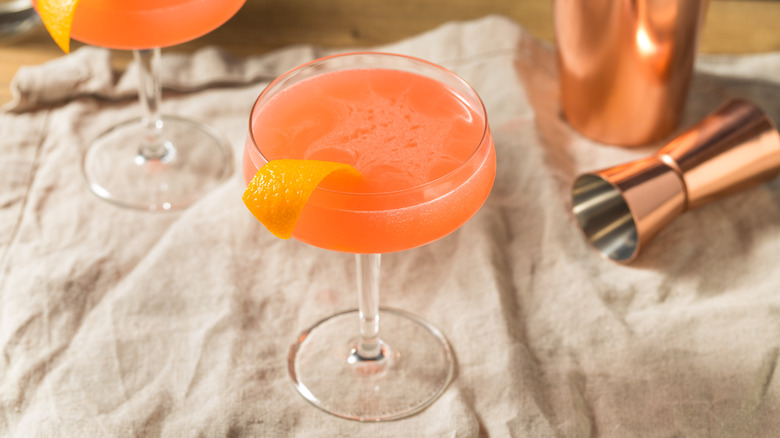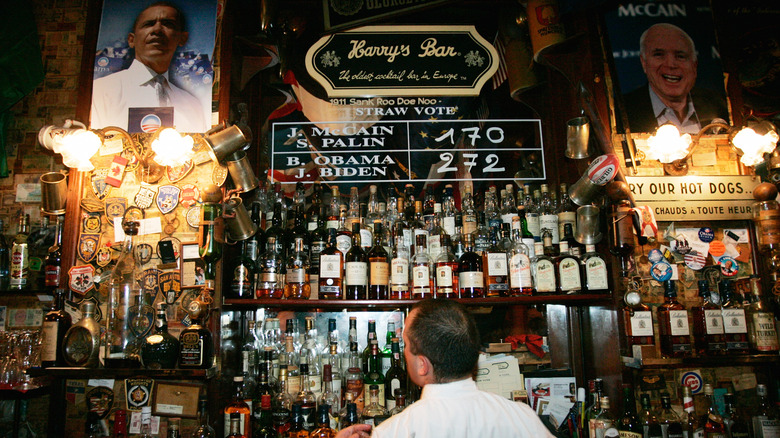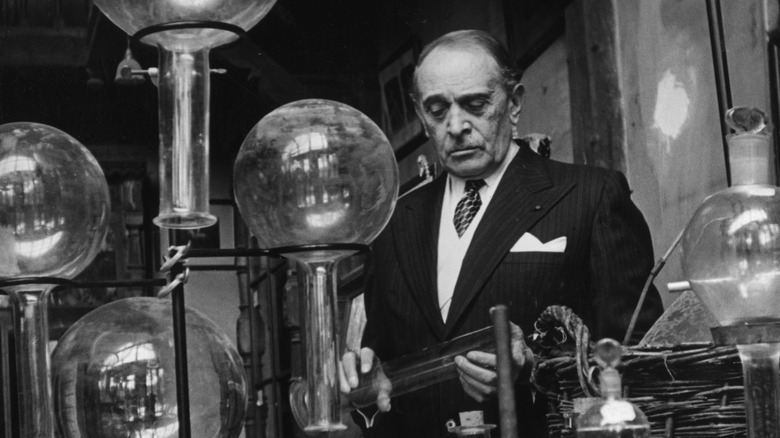The Strange Origins Of The Monkey Gland Cocktail
When you encounter a drink as strangely named as the "Monkey Gland cocktail," it's natural to wonder where it came from. The more pressing question on your mind, however, is probably, "What the heck is that?" Per MasterClass, the Monkey Gland cocktail can be made in four simple steps.
First, add a dash of absinthe (or Benedictine liqueur) to a chilled cocktail glass. Second, mix up dry gin, grenadine, ice, and orange juice in a shaker. Third, strain that mixture into the absinthe glass. Fourth and finally, garnish with something citrusy like a twisted orange peel. The resulting concoction will taste like licorice and, per Cocktail Society, will feature a brightly warm, pinkish hue. Modern sensibilities tend towards sour recipes (think of the Cosmopolitan or a Penicillin cocktail, per Washington Post), however, so be aware, this is a rather sweet combination.
With its carefully considered composition out of the way, let's get back to the real mystery: Where in the world did this beverage come from?
The Monkey Gland hails from a famous bar
We can actually pinpoint the origin of this drink to a specific location. In Paris, there's an establishment called Harry's Bar, although it originally operated in New York. Circa 1911, this bar was dismantled stateside, then reassembled in France. The drinking hole has a long and storied history, having invented cocktails like the White Lady, Tricky Snail, Sidecar, Louisville, James Bond, French 75, and Bloody Mary, as well as — per Cocktail Society — the Angel Face. Nowadays, it offers hundreds of cocktails, including its own creations.
When the bar was first unveiled in the City of Light, it was owned by Toad Sloan, but the now-titular Harry MacElhone was soon hired there and later took over the joint. It was MacElhone who actually came up with the Monkey Gland idea during the 1920s. Newspapers at the time reviewed it favorably, and MacElhone later wrote the beloved recipe down in a 1930s book (this timeline is part of the reason MasterClass lists Benedictine as an absinthe-substitution; at least in the States, absinthe was outlawed for much of the 1900s).
MacElhone is a rather famous mixologist, notes Difford's Guide, having grown up in Scotland before working on both sides of the pond as an expert bartender. His knack for appealing to Americans was so well honed, Harry's Bar ended up becoming something of a tourist trap. Why in the world did he name one of his creations the "Monkey Gland," though?
The cocktail is based on a mad scientist
As a heads-up, what follows is a discussion of pseudoscience and animal abuse. So, you might lose your appetite for the delicious and yet provocatively named cocktail described above. However, we cannot deny that this narrative is morbidly fascinating.
MacElhone seems to have been inspired not by his time spent in Great Britain or the United States but rather by the home country of Harry's Bar. MasterClass explains the drink was named after the work of French surgeon Serge Voronoff, whose debunked theories claimed grafting monkey glands to human reproductive organs could extend people's life expectancy. During the 1920s, via Cocktail Society, Voronoff conducted hundreds of experiments, trying to prove these outlandish beliefs. Unfortunately, as noted by Atlas Obscura, Voronoff was seen as credible by medical professionals; he studied under a Nobel Prize winner, worked with the Collège de France, presented his work to the International Congress of Surgeons in London, got rich enough to buy a castle by charging people for his procedures, and even got a cocktail named after his work. Thankfully, according to VICE, people wised up to the sketchiness of it all by the 1940s, due to science disproving Voronoff's hypotheses.
What does any of this have to do with mixology? We can only assume that the Monkey Gland cocktail is meant to be invigorating. Nevertheless, it's far from the most mouthwatering backstory.


